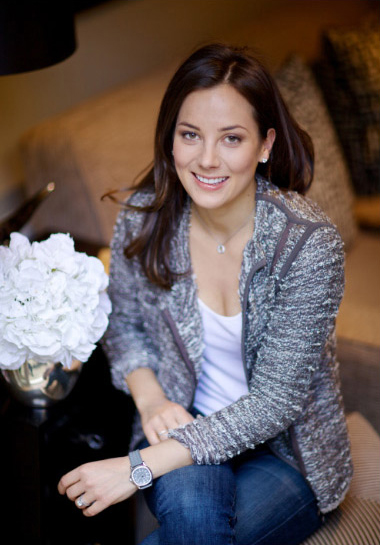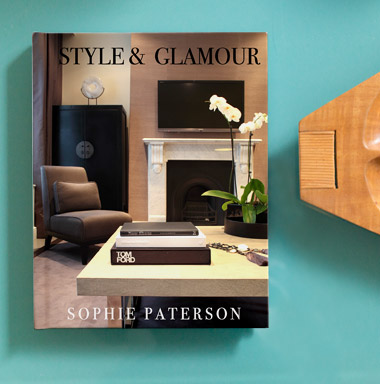An Interview with Interior Designer Sophie Paterson
Recently we came across STYLE & GLAMOUR, a fantastic book of interior design concepts created by London-based designer Sophie Paterson. Intrigued by its combination of accessible design and flat-out luxury, we recently reached out to Sophie to explore how a beautiful book can make a beautiful brand look even better.
Tell us a little about yourself. What’s your design background?
Six years ago, after a previous career in event management, I made the transition to interior design. I was given the opportunity to design the interiors for a developer in Chelsea who was doing a large basement extension and renovation on a townhouse. He had seen my own home after I’d asked him to advise on extending my kitchen into my garage and really liked the interior design. He asked me who had designed it, as he was looking for a designer who shared his taste, and when he found out I did it, he asked me if I’d like to do some work for him.
I had total carte blanche and no set budget to design and furnish the property—an amazing opportunity and introduction into interior design. Those types of projects are incredibly rare! I had no formal training, but working for the developer with his amazingly talented team of structural engineers, carpenters, and builders I learned through hands-on experience and soaked up all the knowledge they generously shared with me. Subsequently I built on my knowledge through studying CAD at KLC in Chelsea Harbour.

We’re intrigued by the title of your book. How would you define “style and glamour” in the world of interior design?
I don’t think it can be defined—for me design, style, and glamour are things you need to see and feel. Like many designers, I’ve always found it quite hard to talk about my work, as I’m a very visual person. I’ve always preferred to communicate through images of my work and let that do the talking.
How did you originally decide to go about actually producing a printed book?
Because of my presence on social media—Twitter and Facebook, and later Instagram and Pinterest, I would receive a large number of emails each week from people asking me where I got certain pieces from, project enquiries, or aspiring designers looking for career advice. I’m naturally quite an open person and like sharing advice with others, but soon it got to the point where if I replied to each individual email I’d never get any work done. I thought it would be good to put all my advice, insider tips, and some images of previous projects in one place where everyone could access it. I’ve always been passionate about animals and I had the idea after visiting the Mayhew Animal Home in London that I’d publish a book and give all the profits to them.
What were you looking for in a publishing platform? Price, quality, speed? All of the above?
First and foremost, I wanted to produce a good quality book—and it had to be reasonably straightforward to produce. I was managing five projects at the time and so I needed to fit the book in around those.
Narrowing down your options can sometimes be the hardest thing when book-making. How did you choose which of your ideas to showcase in your book?
I mostly picked images that illustrated the point or tip I was talking about. I didn’t want to write long essays on the best way to design a room, as that’s boring and no one wants to read about it when they can look at a pretty picture! Some images I culled—even though they were gorgeous, they didn’t fit into the various chapters I wanted to cover.

What do you think the value of sharing your design ideas is in a printed book? How did you decide that was the best way to get your work across?
It’s been hugely valuable to me, even though I set out making the book to raise money for charity—it’s great to have a way to share information with others. It has also had the added benefit of doubling up as a portfolio to give potential clients and it’s a great marketing tool. The fact that it is a book, rather than a leaflet or printout, really sets it apart and the feedback I’ve had has been very positive.
Obviously, in your industry appearance is paramount. How did you go about making sure the quality of your designs really came through on the printed page?
All the photographs used in the book were shot professionally by photographers that specialize in interior design photography. The quality of their work meant that half the battle was already won. After that, I did a single test print to make sure the print quality was good enough—and it was—so I printed quite a few and added the book to our website so others could buy it too.
How do you currently use your book to promote your business? Or was it more of a personal project or a labor of love?
The book is still for sale through our website, and although I don’t promote it, we still sell some each month. It was definitely a labor of love.
How does your book compliment your website? Do they work together?
The book is featured on our website with a flip page preview and a link to the Blurb website where you can buy it.
Do you try to stay active in the interior design community in London? What’s the value of reaching out to other designers?
I do go to lots of industry events, it’s great fun and I like seeing and hearing about what other designers are up to. I have three incredibly good friends who happen to be interior designers in London, we share advice and sources and generally give each other support. Despite our reputation, all the designers I’ve got to know have been so friendly and open.
Now a question for those of us on the other side of the business: What makes for a great client-designer relationship?
I try to get to know the client as quickly as possible, how they like to work, what they want and need, how they like to be contacted, and how much involvement they want. After you know that the vital ingredient is communication at every step of the way.
On a large project it is highly likely something will go wrong—human error or supplier delay—but as long as you communicate it quickly, politely, and with a proposed solution, it generally isn’t a problem. It’s better to over-communicate with your clients rather than leave them in the dark while you try and fix it. By doing the first two things you’ll gain the trust of your client and you’ll have a great client-designer relationship.
What’s your dream design job? Your dream client?
I’d love to design a beach house or cottage. Having recently moved to the country, I’m very inspired by rustic, simple, chic interiors as evidenced by my Pinterest page which is full of images of them! In terms of my dream client, I really value clients who trust you. I often work with clients for several years at a time and working with them is so great, you build up a lot of mutual respect and trust. It’s one of the best things about this job. I can definitely say there are a couple of clients I have at the moment who I will really miss once their project is complete. One is already on the lookout for a second home so that we can work together again!


This post doesn't have any comment. Be the first one!